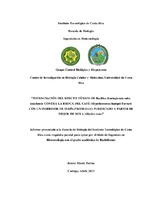Potenciación del efecto tóxico de Bacillus thuringiensis subs. israelensis contra la broca del café (Hypothenemus hampei Ferrari) con un inhibidor de serín-proteasas purificado a partir de frijol de soya (Glycine max)
Resumen
El café es uno de los productos de mayor relevancia comercial en Costa Rica. La plaga más devastadora del café es la broca (Hypothenemus hampei). Dado que el uso de plaguicidas ha sido ineficiente; se ha promovido el uso de formulados a base de δendotoxinas de Bacillus thuringiensis (Bt) para alcanzar un manejo más sostenible de esta plaga. Sin embargo, las proteinasas digestivas del intestino medio del insecto pueden comprometer la efectividad de Bt; por lo que han buscado opciones como la incorporación de inhibidores de proteinasas (IPs) vegetales. El objetivo de esta investigación fue determinar si un extracto de soya (Glycine max) contenía IPs que potenciaran el efecto tóxico de Bt subs. israelenesis contra H. hampei. El perfil proteico del extracto de la broca reveló una banda a 24,1 kDa que se presumió como una tripsín-proteasa, mientras que el extracto de soya mostró una banda a 20,1 kDa que se estimó como el inhibidor Kunitz de tripsín-proteasas. El zimograma copolimerizado con gelatina permitió cuantificar las zonas de actividad del extracto de broca en (0,218 ± 0,457) µg, las cuales fueron suprimidas al incorporar extracto de soya. Los bioensayos mostraron que al añadir una mezcla de cristales de Bti a dosis subletal (1,135 µg∙µL-1 ) junto con dosis incrementales de extracto de soya; la mortalidad sobre H. hampei fue mayor que al incorporar Bti solo, y se alcanzó una mortalidad máxima de 73% con Bti + IPs. Esto implica que la mezcla de los IPs + Bti exhibieron una sinergia significativa Coffee is one of the most commercially important products in Costa Rica. The most devastating pest on this crop is the coffee berry borer (Hypothenemus hampei). Since the use of agrochemicals has been inefficient, alternatives like the use of bioinsecticides based on δ-endotoxins from Bacillus thuringiensis (Bt) has been promoted to achieve a more sustainable management of this pest. Nevertheless, the presence of environmental and digestive proteinases in the insect’s midgut could impact in the effectiveness of Bt. By this reason, researchers have focused to search options like the incorporation of plant proteinases inhibitors (PIs). The objective of this research was determine if a soybean (Glycine max) meal extract had PIs to potentiate the toxic effect of Bt subs. israelensis against H. hampei adult females. The protein profile of the midgut extract revealed an only band at 24,1 kDa that was presumed as a trypsin-proteinase; while the soybean extract showed a band at 20,1 kDa that was estimated as the soybean Kunitz trypsin inhibitor. Clear areas in the zymogram co-polymerized with gelatin were quantified in (0,218 ± 0,457) µg, which bands were supressed by incorporating soybean extract. Bioassays showed that a mixture of Bti crystals to a sublethal dose (1,135 µg∙µL-1 ) added with increased doses of soybean meal extract produced a higher mortality that the use of Bti alone, and the mixture of Bti + soybean extract reached a maximum mortality of 73%. Therefore, PIs exhibited an important degree of sinergy with Bti.
Descripción
Proyecto de Graduación (Bachillerato en Ingeniería en Biotecnología) Instituto Tecnológico de Costa Rica, Escuela de Biología, 2013.


